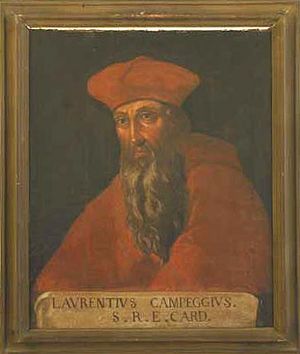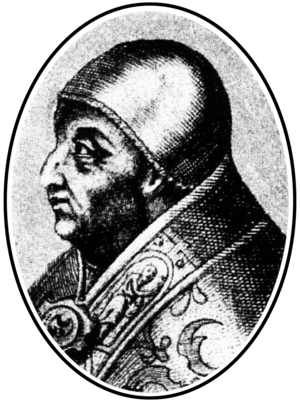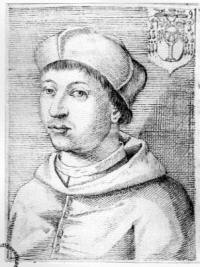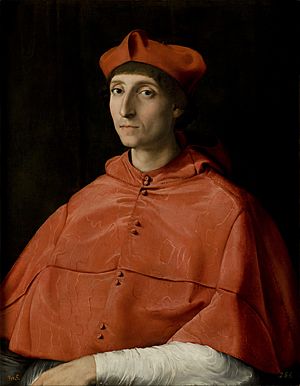Cardinal protector of England facts for kids
The Cardinal protector of England was a special helper for England in the College of Cardinals in Rome. This role existed from 1492 until 1539. A cardinal protector was like a representative for a Catholic country or group within the group of cardinals. The Pope chose this person. This job ended because of the English Reformation, which was when England broke away from the Pope's authority.
The idea of national protectors grew in the 1400s. This happened as countries became stronger and used more diplomacy. Cardinal protectors for religious groups had existed since the 1200s. King Henry VIII said the cardinal protector was like his own person. This cardinal would defend England and its kingdom in all matters in Rome. The cardinal protector spoke for the king in important meetings with the Pope. This was especially true when the Pope and the king shared power over church appointments. The cardinal also led England's diplomats in Rome.
Even though some cardinals did similar jobs earlier, the official role of national protectors was first truly recognized by Pope Julius II. The terms 'cardinal protector' and 'cardinal procurator' were often used to mean the same thing in the 1400s. The first time 'cardinal protector' for England was mentioned was in 1492. But some historians think this was a mix-up with the job of cardinal procurator.
Unlike other countries, the cardinal protectors for England, Scotland, and Ireland were usually chosen only by the Pope. The cardinal was "given" to the country, not chosen by its government. Often, they had no direct connection with the governments of these countries. The English cardinal protector played a big part in choosing church leaders in England. They also had a role in similar choices in Scotland and Ireland.
Contents
Who were the Cardinal Protectors?
Francesco Piccolomini (1492–1503)
Francesco Piccolomini was the first official cardinal protector of England. He later became Pope Pius III. King Henry VII asked for him to be appointed. King Henry VII wanted good relations with Rome. He saw this as a way to protect his country from enemies. He sent his trusted advisor, Christopher Urswick, to Rome in 1492. At that time, Henry VII worried that many English bishops might support his enemies.
There were other disagreements too. For example, there was a tax for the Pope. Also, the Pope had refused to make John Morton, the Archbishop of Canterbury, a cardinal. Henry VII asked for Piccolomini to be cardinal protector in a letter to the new Pope Alexander VI. The Pope agreed to this request.
Piccolomini was already a protector for a religious group. He was also close to German princes. His role as England's protector was the first official one for any country. Henry VII did not mind Piccolomini's German connections. He even thought they would help against France.
Adriano Castellesi (1503–1504)
When Adriano Castellesi became a cardinal in 1503, he became very important for England. After this, new church leaders in England were chosen through Castellesi. Piccolomini himself became Pope Pius III in September 1503. But he died less than a month later. Castellesi did not vote for him.
Castellesi was a favorite of Pope Alexander VI. But this became a problem when Pope Julius II became Pope. Castellesi still presented himself to Henry VII as the main cardinal for English matters in Rome. To keep his position, Castellesi gave his home in Rome to Henry VII. In 1504, Henry VII named Castellesi as the head of his official group of representatives in Rome.
Galeotto della Rovere (1504–1508)
In 1504, Pope Julius II wrote to Henry VII. The letter said that the king had chosen the Pope's nephew, Galeotto della Rovere, as cardinal protector. Castellesi was given a richer church position instead. Castellesi later lost the king's favor and left Rome.
Rovere died in September 1508. This left England without a cardinal protector. Henry VII himself died in April 1509. Another of the Pope's nephews, Sisto della Rovere, took over his brother's church positions. He wrote to Henry VII saying he wanted to keep his brother's friendships. Henry VIII replied that he valued Sisto's friendship. But there is no proof that Sisto was ever offered the protector role.
Francesco Aldiosi (1509–1510)
Cardinal Francesco Adiosi might have become cardinal protector. But his letters to England do not mention this job. A letter from Christopher Bainbridge in 1509 does call Adiosi the protector. Bainbridge was the first English cardinal in Rome in a long time.
Adiosi was later dismissed as protector. The king gave the job to Sisto della Rovere. But there is no clear proof that Sisto ever officially held the title before he died in 1517. Until Pope Julius II died, Bainbridge acted as a protector for England.
When Julius II died in 1513, Castellesi returned to Rome. He and Bainbridge became rivals as representatives for England. Records from this time are missing. So, it is hard to know how much Bainbridge did.
Giulio de'Medici (1514–1523)
In 1514, Silvestro Gigli helped arrange for another cardinal-nephew, Giulio de'Medici, to become cardinal protector of England. Medici later became Pope Clement VII. Pope Pope Leo X wrote to Henry VIII. He praised the king for choosing his nephew as protector.
Medici's appointment made Bainbridge less important. But Bainbridge continued to play a role until his death in July 1514. Gigli was accused of being involved in Bainbridge's death. Medici looked into it and found Gigli innocent. The time between Piccolomini and Medici (1503 to 1514) was when the protector's role was not very clear. The job became much more important when Medici was appointed in 1514. This was partly because Medici and Thomas Wolsey were friends. The job was also important because the Pope and England had a special relationship. England was a strong supporter of the Pope's independence.
Medici also became the protector of France in 1516. This made England unhappy. Medici was elected Pope Clement VII in November 1523.
Lorenzo Campeggio (1524–1539)
Lorenzo Campeggio was close to Medici. He was the cardinal protector for Germany when Medici became Pope. Campeggio received many appointments from Pope Clement VII. Henry VIII chose him as protector for England in February 1524. This was on the condition that the Pope accepted Wolsey as his permanent representative.
Campeggio faced a difficult choice. He was asked to judge if Henry VIII's marriage to Catherine of Aragon could be ended. Catherine was the aunt of Charles V, Holy Roman Emperor. Campeggio decided that the marriage was valid. This decision came after a long delay. The final decision in the case was made in Rome in 1534. That same year, the English Parliament passed a law called the First Act of Supremacy. This law said that Henry VIII was the head of the Church in England. Henry VIII was very unhappy with Campeggio. He noticed Campeggio spent a lot of time with the Emperor. Campeggio also gained a lot of money from new church positions given to him by Charles V.
In January 1531, Campeggio was removed as cardinal protector. But this was not made public until May. At first, it was unclear if Henry VIII would choose a new protector. The king preferred Alessandro Farnese. He told his ambassadors to offer the job to Farnese. If Farnese said no, they should offer it to others.
Pope Clement VII did not know that Henry VIII had secretly married Anne Boleyn. He tried to make peace with the king. He appointed Thomas Cranmer as Archbishop of Canterbury. Cranmer openly supported Henry VIII's annulment. When Cranmer said Henry VIII's marriage was not valid, the Pope threatened to remove Henry VIII from the Church. Henry VIII then stopped all money going to Campeggio from his church position in England. Henry VIII also claimed the right to make church appointments for Campeggio. The English Parliament passed a law that took away Campeggio's English church positions. This was unless he swore loyalty to the king. Two days later, Campeggio was in Rome for the final decision against the annulment.
Historians say that years of working with Popes and cardinal protectors made Henry VIII expect to get his way with the Church of England. Pope Clement VII died in September 1534. He died before learning that the English Church had denied the Pope's authority. In the election for the next Pope, Campeggio was the only cardinal who did not agree with a proposal for non-secret voting. He was also the only cardinal who did not show respect to the new Pope Paul III.
Attempts to Make Peace
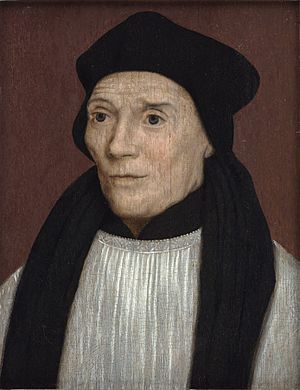
Many people in Rome still hoped to make peace with England. Pope Paul III made two English cardinals. One was John Fisher, who was in prison and sentenced to death by Henry VIII. Fisher's execution made Pope Paul III remove Henry VIII from the Church. While Campeggio was alive, Rome did not try to fill any of the empty church positions in England.
Queen Mary I of England briefly brought England back under the Pope's authority. She appointed Reginald Pole as Archbishop of Canterbury. But this return to the Pope's power in England was in trouble. This was especially true when Mary I married Philip II of Spain. In 1555, Pope Paul IV named a new cardinal protector, Giovanni Morone. But the queen did not agree to this. So, Campeggio remained the last cardinal protector chosen by the English crown.
Meanwhile, being loyal to the Pope became very important for Irish nationalism. Bishops chosen by the Pope gained more followers than the church leaders chosen by the English crown. Historians say that the cardinal protectors helped the Pope lose England. But Ireland stayed loyal to the Pope despite them.
List of Cardinal Protectors
- Francesco Piccolomini (later Pope Pius III), first cardinal protector of England (before 1492 – 1503)
- Adriano Castellesi, acted as protector for England and official protector of Germany
- Galeotto Franciotti della Rovere (1505–1508)
- Francesco Adiosi (1508–1510)
- Giulio de'Medici (1514–1523) (later Pope Clement VII)
- Lorenzo Campeggio (1523–1534, died 1539)
- Not confirmed by the English crown
- Giovanni Morone (1578–1579)
- Philip Howard (1682–1694)
- Filippo Antonio Gualterio (around 1717)
- Cardinal Baschi (around 1797)
- Ercole Consalvi (around 1817, acting)
- Similar roles before the official protectors
- Thomas of Jorz, representative for Kings Edward I and Edward II of England (1305–1310)
- Ferry de Clugny, worked in Rome for Edward IV of England (died 1483)
|


